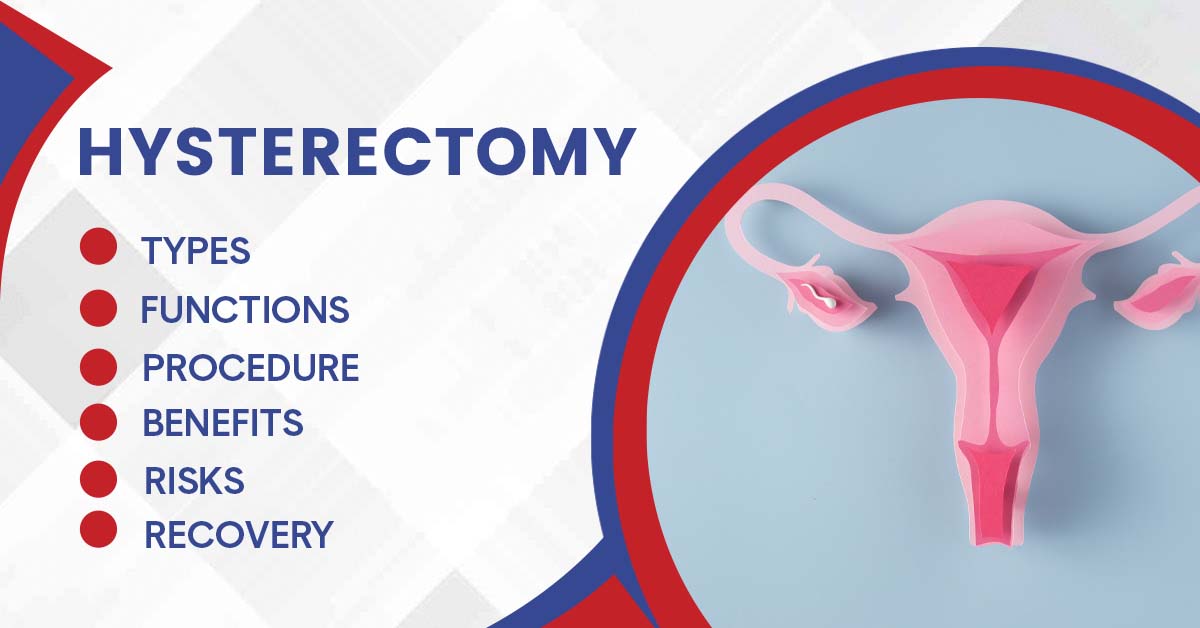What is a Hysterectomy?
A hysterectomy involves surgically removing the uterus and, most likely, the cervix. Depending on the goal of the procedure, a hysterectomy may require the removal of surrounding organs and tissues, such as the ovaries and fallopian tubes. In the uterus, a baby develops throughout pregnancy. Its lining is created from the blood you lose throughout your menstrual cycle. You lose the ability to get pregnant after a hysterectomy, and you also cease having periods.
Types of Hysterectomy:
Hysterectomies can take many different forms. Depending on why you require the procedure and how much of your womb and associated reproductive system can be safely preserved, you may have one of several types.
The main types of hysterectomy are:
- The most frequent procedure is the total hysterectomy, in which the womb and cervix (the neck of the womb) are removed.
- Subtotal hysterectomy: the cervix is left in place while the womb’s main body is removed.
- Total hysterectomy with bilateral salpingo-oophorectomy entails the removal of the womb, cervix, fallopian tubes, and ovaries.
- In a radical hysterectomy, the womb and all of the tissues around it are removed, along with the ovaries, fallopian tubes, part of the vagina, and fatty tissue.
Causes of Hysterectomy:
You may need a hysterectomy to treat:
- Gynecologic cancer. The optimal course of treatment for gynecologic cancer, such as cancer of the uterus or cervix, may involve a hysterectomy. Your other options may include chemotherapy or radiation, depending on the type of cancer you have and how far along it is.
- Fibroids. The only certain, long-lasting treatment for fibroids, benign uterine tumors that can result in recurrent bleeding, anemia, pelvic pain, or pressure in the bladder, is a hysterectomy. Depending on the extent of your discomfort and the size of the tumor, nonsurgical treatments for fibroids may be an option. Numerous fibroids-afflicted ladies experience few symptoms and don’t need any therapy.
- Endometriosis. Endometrium, the tissue that lines the inside of the uterus, develops on the ovaries, fallopian tubes, or other pelvic or abdominal organs in endometriosis. You could require a hysterectomy in addition to the removal of your ovaries and fallopian tubes if medication or conservative surgery doesn’t alleviate endometriosis (bilateral salpingo-oophorectomy).
- Uterine prolapse. Weakness in the tissues and ligaments that support the uterus might cause it to descend into your vagina. Urinary incontinence, pelvic pressure, or bowel obstruction are all symptoms of uterine prolapse. In order to treat these diseases, a hysterectomy may be required.
- Abnormal vaginal bleeding. When alternative measures fail to stop the bleeding, a hysterectomy may provide relief if your periods are heavy, unreliable, or protracted each month.
- Chronic pelvic pain. Sometimes women who endure persistent pelvic pain that originates in the uterus must resort to surgery. However, many types of pelvic pain cannot be relieved by a hysterectomy, and an unneeded hysterectomy may lead to new issues. Before performing such a significant procedure, get a detailed examination.
You Can Read also: Pregnancy Yoga Stretches
The Procedure of Hysterectomy:
The following are some examples of the various hysterectomy surgical techniques.
- Abdominal Hysterectomy: This kind of hysterectomy entails the removal of the uterus through a significant abdominal incision.
- Vaginal Hysterectomy: Through a tiny incision in the vagina, the uterus is removed during this type of hysterectomy.
- Laparoscopic Hysterectomy: The uterus is removed using a laparoscope in this method. A laparoscopy is a procedure using a tube-shaped device with a camera and a bright light.
- Radical Hysterectomy: The uterus, cervix, fallopian tubes, and ovaries are removed during this procedure. Typically, a vertical or low transverse incision is used.
- Robot-assisted laparoscopic Hysterectomy: In this method, the surgeon performs a laparoscopic procedure to remove the uterus while controlling a robot externally.
Treatment of Hysterectomy:
You might undergo tests to determine whether you have cancer before surgery, which could alter how your surgeon approaches the procedure.
- Cervical cytology (Pap test), which looks for abnormal cervical cells or cervical cancer, is one possible test.
- Endometrial biopsy, which looks for endometrial cancer or abnormal uterine cells
- Pelvic ultrasound, which may display the size of ovarian cysts, uterine fibroids, or endometrial polyps
An anesthesiologist will give you either:
- In a general anesthetic, you won’t be conscious during the procedure.
- In regional anesthesia, also known as epidural or spinal anesthesia, drugs are injected close to the lower back nerves to “block” pain while you’re awake.
Your healthcare professional may carry out a hysterectomy using one of the following surgical techniques:
Vaginal Hysterectomy:
- To remove your uterus, a cut is made at the top of your vagina. There isn’t an exterior cut.
- Thread that dissolves is used to stitch the vagina.
- Most usually used to describe benign or noncancerous conditions like uterine prolapse.
- The preferred approach has the fewest issues and recovers the fastest (up to four weeks).
- The day after surgery, most patients go home.
Laparoscopic hysterectomy:
- A laparoscope (a thin tube with a video camera on the end) is inserted into the lower abdomen through a very small belly button incision.
- The placement of surgical instruments requires several additional very small incisions.
- Your uterus can be removed in pieces through incisions made in your belly or through your vagina.
- Some patients check out of the hospital that day or the next morning.
- In comparison to an abdominal hysterectomy, full healing occurs more quickly and with less discomfort.
Robotic-assisted laparoscopic hysterectomy:
- Your surgeon performs the procedure with the use of a robotic tool.
- Once a laparoscope has been inserted into the abdomen, the pelvic area can be seen.
- Around the belly button, three to five incisions are made to implant the teeny, thin surgical instruments. The robotic arms and apparatus are under the surgeon’s control.
- The recovery is rapid, much like a laparoscopic hysterectomy.
Abdominal Hysterectomy:
- Your uterus is removed through an abdominal incision that is six to eight inches long.
- The incision is made either across the top of your frontal hairline or from your belly button to your pubic bone. Stitches or staples will be used by the surgeon to seal the incision.
- Most usually used in cases of malignancy, uterine enlargement, or disease that has spread to other pelvic areas.
- It typically necessitates a lengthier recuperation period as well as a longer hospital stay (two or three days).
Benefits of Hysterectomy:
In every surgery, issues are treated or avoided. Any type of hysterectomy has advantages over not removing organs, including
- stopping excessive, unusual bleeding
- relieving persistent pain
- reestablishing painless sex
- avoiding cancer
- Getting rid of malignant tissue
- enhancing the standard of living
You Can Read also: Human Reproductive System in Male and Female
Risks & Recovery of Hysterectomy:
There is a slight possibility of problems, such as
- heavy bleeding
- infection
- damage to your bladder or bowel
- a serious reaction to the general anesthetic
After a vaginal or laparoscopic hysterectomy, recovery usually takes three to four weeks.
Recovery from an abdominal hysterectomy can take between 4 and 6 weeks.
Age and general health are other factors that affect how quickly someone recovers.
- unable to drive for two weeks.
- cannot lift anything heavier than a grocery bag for six weeks.
- may feel tired for the first six weeks.
- may experience vaginal discharge and spotting for eight weeks.
- cannot pierce the vagina for eight weeks.
The recuperation process can be aided by modest exercise, such walking.
- obtaining a lot of sleep.
- all surgical incisions should be kept dry and clean.
- Avoid wearing tight clothing
- Look for infection symptoms on a frequent basis on incisions.
- Avoid letting water immediately contact a shower incision.
- washing the area delicately.
- taking prescription drugs as directed.
After the procedure, a person usually stays in the hospital for 1-2 days before going home to heal. Depending on the type of hysterectomy, this period may change. A stay of 1-2 days may be necessary after abdominal surgery.


